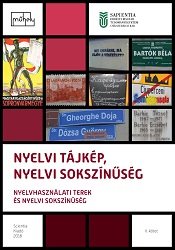Új trendek és irányzatok a nyelvoktatásban
New Trends and Orientations in Language Teaching
Author(s): Zsuzsanna Dégi
Subject(s): Language and Literature Studies
Published by: Scientia Kiadó
Keywords: language teaching; globalization; multilingualism
Summary/Abstract: Globalization, technological development as well as international mobility and communication have enhanced work and research on multilingualism. Multilingualism has also spread in the field of education – numerous school curricula include the teaching of four–five languages or even more.In the last 15 years, more and more studies concerning education and/or language learning adopt a social approach, paying more attention to the linguistic needs of students, their language behaviour and practices, and the language environment in which the teaching/learning process is taking place. From such perspective, language is considered as a resource, wherefore the ultimate goal of language teaching is not the perfect acquirement of one or more languages but the development of such a linguistic repertoire where each language has its own place and role (CE 2001: 5).Researchers dealing with the so-called holistic multilingual education are interested in new language teaching methodologies through which language boundaries become blurred and softened, such as „translanguaging” (Portolés & Martí 2017), the study of cognates and false friends in vocabulary teaching (Carlo et al. 2004, Cenoz & Gorter 2011, Otwinowska 2016), or the development of metalinguistic awareness (Cenoz & Gorter 2011, 2015).The present study aims to present briefly the above mentioned approaches to language teaching as well as the results of interviews carried out with high school English teachers concerning their classroom language use.
Book: Nyelvi tájkép, nyelvi sokszínűség II. Nyelvhasználati terek és nyelvi sokszínűség
- Page Range: 191-201
- Page Count: 11
- Publication Year: 2018
- Language: Hungarian
- Content File-PDF

